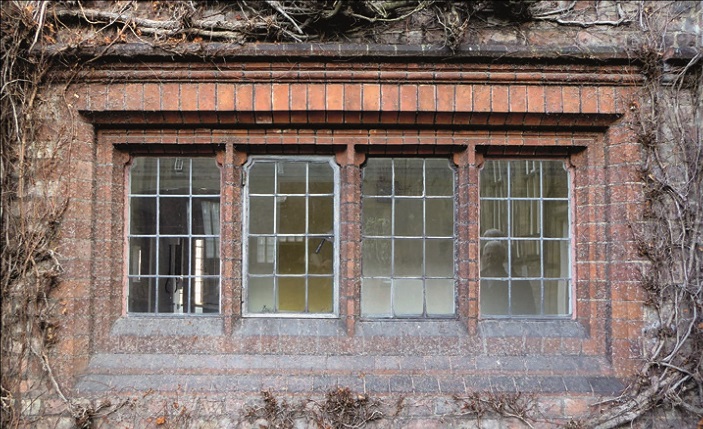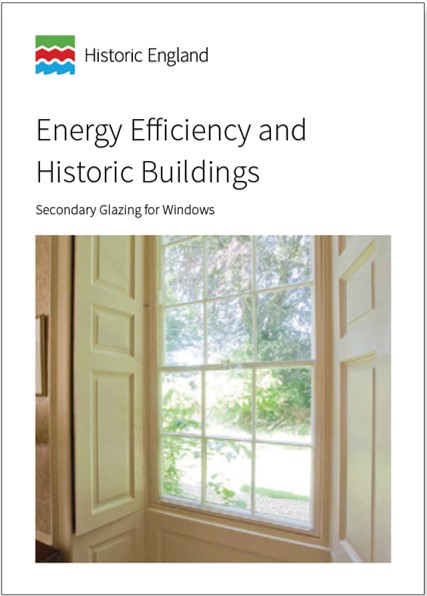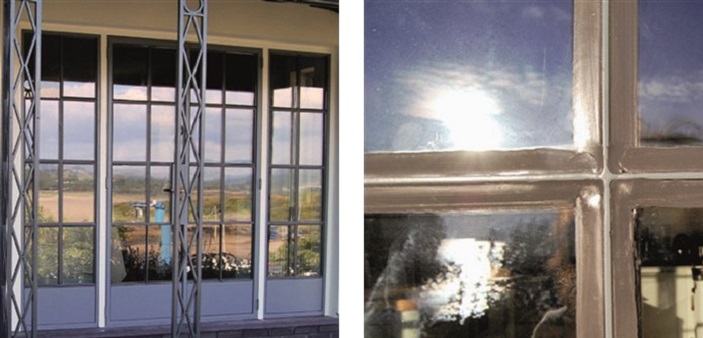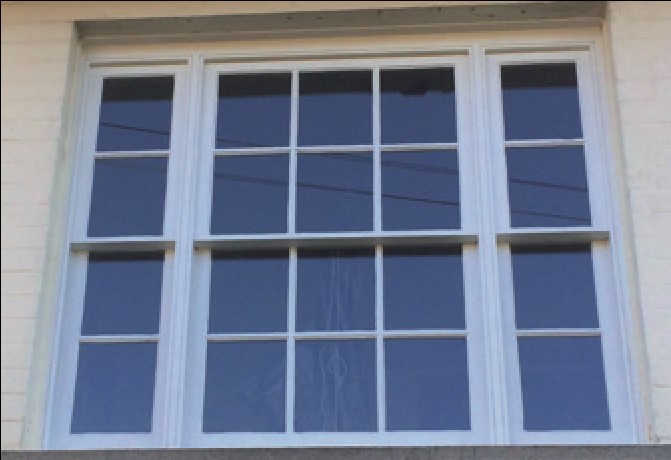The Thermal Upgrading of Historic Fenestration
Eleni Makri
 |
||
| Late 19th century neo-Tudor leaded lights in wrought iron frames at St John’s University in York would require intricately shaped secondary glazing panels. (Photos: Eleni Makri) |
The thermal upgrading of traditional single-paned windows is one of several excellent means of responding to a universal call for reducing our carbon footprint and making existing buildings more thermally efficient. Significant improvements can often be made without interfering with historic value or original aesthetics.
Thermal improvement options range from simple draughtproofing measures and the addition of thermal blinds or secondary glazing, to the actual replacement of glass panes with slim double glazing. These can be combined to great effect, with appropriate options depending on the significance of the fenestration, its condition and type. Where the historic fabric is of particular significance, appropriateness may depend on whether the proposal can be considered reversible.
SECONDARY GLAZING
A report published in 2012 by the Sustainable Traditional Buildings Alliance (STBA) and its partners, which included English Heritage (now Historic England) and the RIBA, highlighted the experimental research and testing carried out by Historic Scotland and English Heritage at Glasgow Caledonian University (Baker 2008). These demonstrated that when historic windows are being thermally upgraded, the best results are achieved with secondary glazing, not double glazing (See table). This is particularly significant where a building which is listed or in a conservation area retains original fenestration complete with its original glass, as the requirement for listed building consent and sometimes planning permission is likely to dictate retaining original fabric. In this case the only thermal upgrading option would be secondary glazing.
In the case of Quad East (1891) at St John’s University in York, for example, the Grade II-listed building retained original fenestration of high value throughout. As illustrated above, the style is neo-Tudor with square-paned leaded lights in wrought iron frames which are fixed directly onto the brickwork jambs and mullions. Original handles and stays survived in all the opening casements. Deciding on the best way to install secondary glazing can be quite complex, balancing the need for minimum disruption to original fabric and appearance while achieving the best possible thermal upgrade. The choice is not always obvious.
 |
||
| Historic England's guide to secondary glazing. |
In recent years the glazing industry has developed a number of secondary glazing options which are quite elegant and discreet. Importantly, the designs continue to evolve. Storm Windows for example, has produced a slim vertical sliding product in slender aluminium sections which can be installed on the staffing bead of a vertical sliding sash, providing a reversible and visually discreet thermal upgrading solution for original sliding sashes even where the original shutter boxes and shutters survive. Likewise, Selectaglaze offers an extensive range of secondary glazing in opening casements which can be suitably detailed to allow the original window to be opened as before. Where original casements open outwards, secondary glazing can be installed opening inwards; for inward opening ones and tall, narrow horizontal pivots, the secondary glazing can also be inwards opening but with extended hinges so that the secondary casement can be folded back fully out of the way.
Each building is unique and success depends on how the new frames are installed within the reveal and how they relate to the original details. Results are best when the approach is design-led rather than product-led, and it pays to employ a specialist conservation architect. A common misconception is that secondary glazing can also provide sound insulation, but strictly speaking this is not the case. Best thermal performance is achieved when the secondary glazing is installed as close as possible to the original window, while sound-proofing would require the biggest distance possible between the two.
SLIM DOUBLE GLAZING
The development of reliable slim double glazing units has enabled heat loss to be reduced by approximately 50 per cent. These units, which may be acceptable replacements for non-original glass panes in historic windows, can be less than 12mm thick, can combine mouth-blown glass on the external pane, and can be putty finished.
Putty How the perimeter of the glazing unit is finished is a key element in the specification. Until recently standard linseed oil putty could not be used as it could cause damage to the double glazing seal. Instead, a proprietary putty had to be used (such as Hodgson Sealants’ hybrid polymer-based putty) which needed to be left to mature before being painted to match the fenestration. Technology, however, keeps moving along and a traditional finish can now be achieved by applying linseed oil putty over the butyl bedding compound of the slim double glazing (see diagrams).
 |
||
| Slim double glazing in the new metal windows of an extension to a 1930s house in North Wales: rather than a conventional bead, coloured silicone was used like putty to create a more traditional detail. However, the contractors first used the black silicone shown here before replacing it with one that matched the colour of the new metal frames. (Photos: Eleni Makri) |
It is important to stress that the visual integration of slim double glazing with traditional work depends on engaging an appropriate specification as well as on craftsmanship. Where a proprietary putty is used over a butyl bedding compound, the putty must be allowed adequate time, at least a week, to mature before painting it, as otherwise the paint will wrinkle and crack as illustrated opposite. Once hardened, the putty should be over-painted by 2mm to ensure protection of the slim double glazing seal. The minimum putty rebate is 6mm x 6mm.
In cases where painted putty finishes cannot be employed, such as for example in wide W20 mild steel frames, the use of silicone which is coloured to match the frames can be an appropriate alternative, provided it is carefully applied. Beads, however, should never be used to secure the glazing in place as this fixing method is a distinctly modern detail which would conflict with the character of traditional architecture.
Thickness The slimmest possible double glazing is 11–12mm thick (4mm glass + 3-4mm cavity + 4mm glass). These units can be installed to a glazing bar as thin as 16mm wide x 22mm deep with a feather (see diagram) 4mm wide and 20mm deep. If required, the thickness of the double glazing can go down to 10mm or 11mm if 3mm glass is used on both the inside and the outside or just the outside. It should be noted that the U-value of the unit depends on the size of the cavity (and other relevant matters) but crucially not on the thickness of the glass.
These dimensions pretty much determine whether an existing window can be slim double glazed or not, but there are other issues too which are equally important, such as whether the existing glazing is original, and whether the frame is strong enough to carry the weight of the new glazing. The weights of existing sliding sashes would also need to be adjusted to the heavier weight of glass.
 |
||
| Minimum glazing bar dimensions in slim glazing units can match most historic examples. (Diagrams by courtesy of Slimlite Double Glazing Ltd) | ||
 |
Slim double glazing units can be used for fenestration incorporating small panes, such as those of Georgian sash windows or Arts and Crafts casements, with 100mm x 100mm being the smallest possible pane size.
Glass The variety of glass types available has improved dramatically and the external pane can now be made using mouthblown cylinder glass which replicates the irregularities and slight distortion commonly found in old windows. By comparison, modern float glass, which was introduced in the 1950s, has a perfectly flat and regular reflection. As this is less sympathetic to the character and significance of older windows, there is clearly some incentive for replacing single glazed modern glass in historic buildings – from the perspectives of both heritage and energy conservation.
Thermal performance How glazing performs depends on a number of factors. Importantly, the use of warm edge technology in the perimeter spacer can ensure insignificant difference in the U-values between the centre of the glass pane and its edge. As an example, the combination of 4mm clear-float or reproduction-crown glass externally with a 4mm low emissivity glass internally, with the emissivity coating on the inside face of a 4mm cavity filled with xenon or krypton gas, tests at a U-value of 1.9 (W/m²K), which is pretty close to the Building Regulations requirement of 1.6. A 6mm cavity will achieve a U-value of 1.4, which is beyond the requirement. Without the emissivity coating this drops to 2.9, which is still a significant improvement on single glazing.
In practice it would be appropriate for the specifier to look for suppliers whose windows have UKAS Certified U-values (to BSEN1279) and a perimeter seal with a depth of 5mm – the depth at which slim double glazing looks, from any distance, like single glazing.
Another approach is to use Pilkington Spacia which has an overall thickness of 6.2mm. In this glazing unit the two sheets of glass are held apart by a grid of transparent plastic studs and almost all the air has been sucked out of the space. The result is a gap of just 0.2mm, yet the glazing unit is able to meet current Building Regulations requirements, with a centre-pane U-value of 1.1 W/m2K. These units can be used with a traditional putty, and the minimum pane size is 200 x 350mm. However, there is a small black or silver cap, 12mm in diameter, on every unit to cover the point from which air was removed, and on small paned windows this will be more noticeable.
DRAUGHT PROOFING
Slim double glazing works well with timber fenestration, but it is not adequate on its own. It is important that the window has also been draughtproofed and weatherproofed so as to avoid heat loss through gaps, particularly between sash windows and their frames.
On the other hand, when introducing secondary glazing it is important to ensure that any condensation formed between the two panes can evaporate and so the original window (now the external pane) should be kept ‘leaky’. This is particularly relevant with reference to options for draughtproofing original fenestration, which should be avoided if a combined installation of slim double glazing and secondary glazing is being considered.
REPLACEMENT WINDOWS
 |
||
| Wrinkled paint on fresh putty – the putty needs to mature for a week or so for a film to form before painting it. (Photo: Eleni Makri) |
There are occasions where the replacement of whole windows is acceptable or even desirable – usually where modern windows have been introduced and are considered out of character with the surviving originals. In these cases using slim double glazing may enable the original design to be accurately replicated while improving on its thermal performance.
A good example of this was a traditionally detailed house on the Herbert Collins Estate in Southampton (illustrated above) which had lost some of its original sliding sash windows in 2007 when the owners replaced them with PVCu. Unusually, the originals were made of mild steel. As the house was in a conservation area covered by an Article 4 direction, reinstatement was enforced by Southampton City Council.
Research, which included consulting the Crittall technical advisor, established that historic examples of sliding sashes in mild steel are rather rare and so extremely expensive to reproduce in small quantities. One idea discussed with the local authority conservation officer was to replace the PVCu frames with mild steel casements. However, even this option proved to be prohibitively expensive because of the complexity of the three-light arrangement, and so it was eventually agreed to install sliding sashes in timber instead. The design of the replacement was guided by the character and appearance of the conservation area which includes fenestration in both steel and timber.
It had always been the intention to incorporate slim double glazing in the replacements so as to meet the Building Regulations provision for new work in historic buildings. In the completed work, the painted finished putty of the glazing and the perception of the actual slim double glazing as single glazing from any angle made this an appropriate and successful specification for the conservation area. However, the work meant increasing the size of the openings internally so that the significantly thicker timber frames could be concealed behind the external brickwork. This enabled the alignment of the timber replacements with the slim sight lines and glazing bars of the surviving original steel fenestration.
SPECIAL CONSIDERATIONS – METAL FENESTRATION IN MILD STEEL
One of the main problems in the thermal upgrading of fenestration in mild steel is that historic sections were not thermally broken, so adding double glazing would not resolve the problems of condensation and heat loss as a result of cold bridging through the metal. (Leaded lights have the same problem although in this case the fine leading and small panes could never be replicated by double glazing anyway.) The only way of overcoming these problems is through the introduction of secondary glazing.
 |
Decisions can be more complex when dealing with fenestration in mild steel of the interwar period. Windows dating from the early 1930s tend to be of the ‘medium universal suite’ sections. The design was introduced by Crittall in 1918–20, and the sections were subsequently adopted by all manufacturers. As they were produced before the introduction of galvanising in the 1950s, interwar steel windows are prone to rust and their condition depends on how well they have been maintained. It is also relevant that they went out of production in 1965 so any splicing repairs proposed are largely reliant on the availability of salvaged windows of the period or bespoke fabrication from currently available sections.
As with most forms of metal corrosion, rust is an electrochemical process. Left unchecked, rust formation where paintwork has failed will spread beneath the paint. So, before any work is undertaken, full repairs should be carried out in the workshop to ensure that all rust on the original frames has been completely eliminated. This is to avoid carrying out expensive work to continuously deteriorating iron fabric, which would risk wasting available funds.
IN SUMMARY
Both secondary glazing and slim double glazing can contribute significantly to the thermal improvement of the fenestration of historic buildings without compromising original appearance if carefully detailed. Research carried out at Glasgow Caledonian University in 2008 concluded that secondary glazing can give better thermal results than double glazing. On the other hand, double glazing can now be very slim and incorporate both a putty finish and mouth-blown glass, so where the original glass has been replaced with float glass, the new glazing can provide better visual results. Whether replacement slim double glazing or window replacement is acceptable will therefore depend on whether the fabric is original. However, where there are extremely thin timber sections or original steel fenestration, secondary glazing may be the only option. In all cases, the key to a successful outcome would be engaging an appropriate detailed specification centred on restoring or maintaining historic fabric and its appearance while improving thermal performance, all of which is demonstrably possible.
Recommended reading
 |
||
| Fine timber double-glazed replacement windows in a house on the Herbert Collins Estate in Southampton, successfully replicate the fine sections of the original metal sash windows, but not their excessive heat loss. (Photo: Robert Williams) |
STBA, Responsible Retrofit of Traditional Buildings, 20 September 2012
Dr Paul Baker, Thermal Performance of Traditional Windows, Glasgow Caledonian University and Historic Scotland 2008
Jonathan Taylor, ‘Secondary Glazing’, The Building Conservation Directory 2011
Michael Tutton and Elizabeth Hirst (Eds), Windows: History, Repair and Conservation, Donhead Publishing 2007
Chris Wood, ‘Thermal Performance of Historic Windows’, The Building Conservation Directory 2008
English Heritage Practical Building Conservation: Glass & Glazing, Ashgate, Farnham 2011
Energy Efficiency and Historic Buildings: Secondary Glazing for Windows, Historic England, London 2016
Traditional Windows: Their Care, Repair and Upgrading, Historic England 2017



